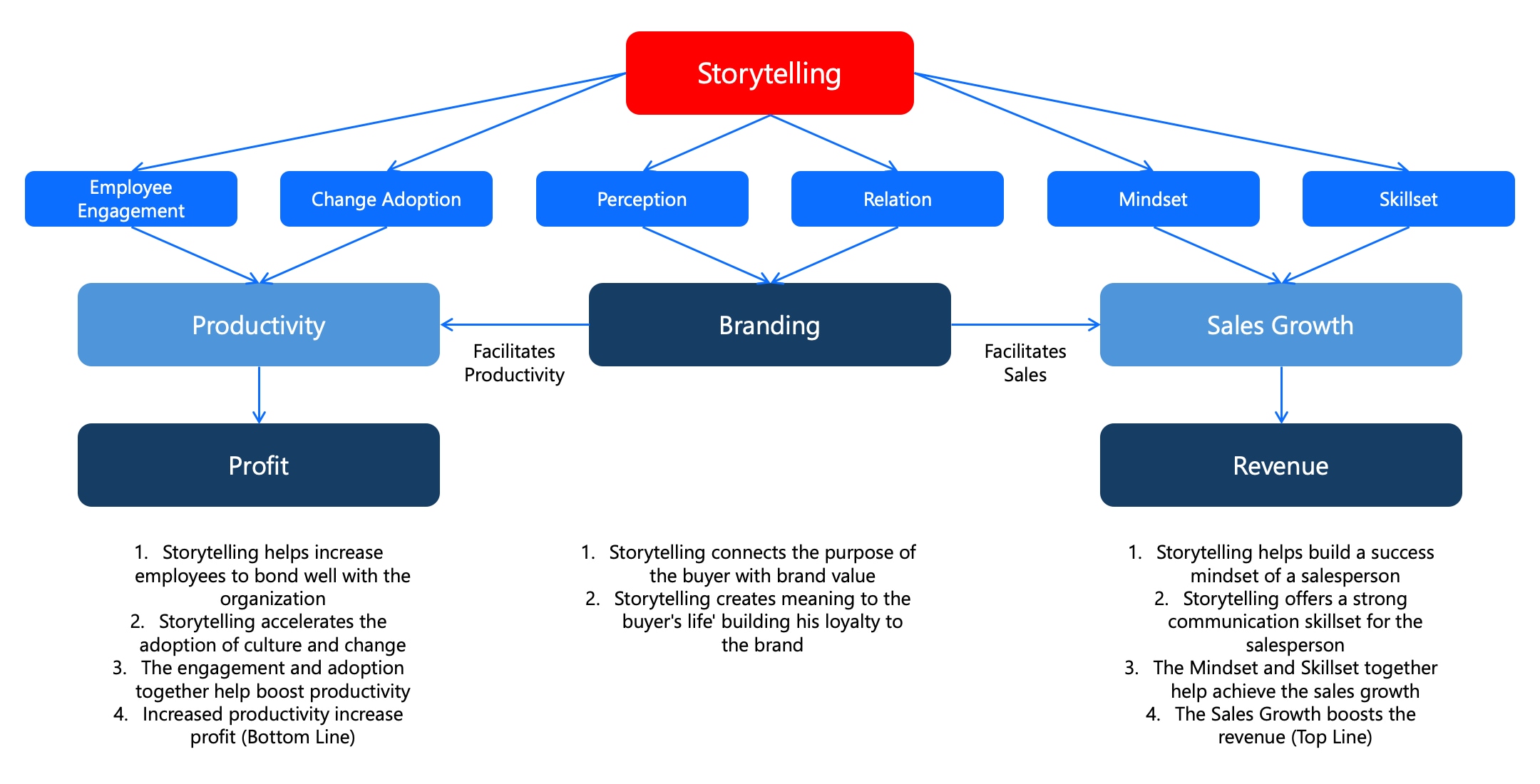In an era dominated by data, automation, and metrics, storytelling might seem like a soft skill—more art than science. Yet, businesses that master storytelling are reaping measurable benefits across productivity, branding, and sales. Storytelling is more than just weaving a narrative; it’s a strategic tool that shapes perception, drives culture, and powers growth.
Let’s break down how storytelling impacts various dimensions of a business and why it deserves a central role in your strategy.
Storytelling Drives Employee Engagement and Change Adoption
A company’s internal culture can either be its greatest asset or its biggest challenge. Storytelling plays a vital role in enhancing employee engagement, helping people connect emotionally with the organization’s mission and values.
Employee Engagement:
Storytelling creates a shared narrative within the workplace. When employees hear stories about the company’s origins, struggles, and successes, they feel part of something bigger than themselves. It humanizes leadership and gives meaning to day-to-day work.
Example: Microsoft uses internal storytelling through its “Microsoft Life” blog, showcasing stories from employees around the world. These stories build pride, belonging, and motivation across global teams.
Change Adoption:
Resistance to change is natural. But storytelling can ease transitions by framing change in a way that resonates emotionally. It shifts people from fear to inspiration.
Example: When Airbnb rebranded with the “Bélo” symbol, the leadership told the story of belonging—how people around the world can feel at home through shared experiences. The story wasn’t about a logo; it was about a mission. This narrative helped employees and customers alike embrace the brand’s evolution.
Together, engagement and change adoption lead to increased productivity. When people are emotionally invested and aligned with change, they work more efficiently, collaboratively, and with greater purpose.
Productivity Translates into Profit
Engaged employees who adapt to change easily contribute to higher productivity. And in business, productivity is a direct contributor to profitability.
Storytelling enables organizations to rally their teams, align goals, and boost morale—leading to better performance and output. When productivity increases, operational costs go down, output quality rises, and the bottom line improves.
Example: Salesforce integrates storytelling into internal communications and training. Their employees don’t just learn “how” to do things, but “why” it matters—leading to a culture of innovation and performance that has helped the company scale globally.
Storytelling Shapes Perception, Builds Relation, and Drives Branding
Externally, storytelling is the engine behind powerful branding. It influences how customers perceive a brand, how they relate to it, and how loyal they become.
Perception and Relation:
People don’t buy products—they buy stories. Stories trigger emotions, and emotions influence decisions. A brand that communicates its values, mission, and impact through storytelling becomes relatable and trustworthy.
Example: Dove’s “Real Beauty” campaign changed the conversation around beauty standards. Instead of selling soap, they sold empowerment—connecting deeply with customers and boosting brand loyalty.
Branding:
Storytelling transforms your brand from a commodity to a community. It’s the difference between a one-time transaction and long-term loyalty. By consistently telling stories that reflect your brand values, you build a strong emotional connection.
Example: Patagonia’s brand is rooted in environmental storytelling. Their stories about activism, sustainability, and ethical manufacturing not only support their branding but also attract a loyal customer base that shares those values.
Effective branding also facilitates productivity internally and sales externally. When your brand story aligns with your internal culture and external messaging, your team works better, and your customers buy more.
Mindset and Skillset Fuel Sales Growth
Beyond branding, storytelling directly contributes to sales growth by enhancing the mindset and skillset of sales professionals.
Mindset:
Stories inspire belief—in the product, the mission, and the salesperson’s own capabilities. A positive, confident mindset leads to better engagement with prospects and persistence in the face of rejection.
Skillset:
Storytelling is one of the most powerful communication tools in a salesperson’s toolkit. It enables salespeople to connect emotionally with customers, overcome objections, and make the product or service relevant to the buyer’s life.
Example: HubSpot trains its sales team to use storytelling in pitches—crafting narratives around customer pain points and desired outcomes. This approach converts abstract features into meaningful benefits, leading to higher close rates.
When the right mindset and skillset come together, they create conditions for exponential sales growth, ultimately increasing revenue (the top line).
Branding and Sales Growth – A Reinforcing Loop
Branding and sales growth don’t operate in silos—they reinforce each other. A strong brand makes selling easier. Conversely, sales success enhances brand credibility. And at the center of both is storytelling.
When storytelling aligns with brand purpose and customer needs, it creates a seamless journey—from awareness to consideration to purchase and loyalty.
Example: Apple’s “Think Different” campaign told stories of rebels and visionaries. It wasn’t about features; it was about identity. This storytelling not only strengthened branding but also fueled one of the most loyal customer bases in tech history—translating directly into sales growth and revenue.
Final Thoughts: Storytelling as a Strategic Business Asset
The business case for storytelling is clear. It’s not fluff—it’s fuel.
- It increases employee engagement, leading to higher productivity and profit.
- It enhances branding by shaping perception and building emotional relation with customers.
- It boosts sales growth by empowering salespeople with the right mindset and skillset.
- And it drives revenue by translating trust and connection into transactions.
In short, storytelling isn’t just a nice-to-have—it’s a must-have.
Whether you're a startup founder pitching investors, a marketing leader defining a brand, or a sales manager training your team, the ability to tell compelling stories can make the difference between good and great.
So, ask yourself: What story is your business telling—and is it one worth remembering?

